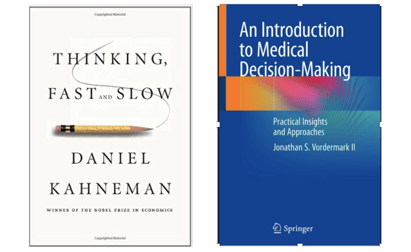Our Thinking
An Introduction to Medical Decision-Making
Take a look at the two books pictured below.

The one on the left, I assume you’ve already read. It’s the classic tome in “Behavioral Economics,” and it is NOT our book recommendation for today. As the title of that book indicates, human beings basically have two very different styles of thinking. System 1 lets us do “no brainer” kinds of activities like driving our car along a known route to work, and System 2 which lets us deal with new and complicated problems like solving an algebra equation.
But you already knew all of that! It is in the book on the right, Vordermark’s An Introduction to Medical Decision-Making, that we learn that medical decisions are also made using a dual system. Here, the first system diagnoses based on “pattern recognition” of a patient’s condition, while in the second system, diagnosis is achieved by generating several hypotheses as to what is wrong with a patient, collecting evidence, and finally by the “elimination” of hypothesized diagnoses that don’t match the evidence. Here’s the kicker. While most pharmaceutical marketing is designed to deal with the elimination model, most medical decision making is actually based on the less cognitive, System 1-like approach. Here, the doctor arrives at a diagnosis through pattern recognition, and chooses a treatment protocol based on habit.
You’ll learn all about that in this book. You will also learn how “heuristics” take on a special role in medical decision making, and how different kinds of “biases” can untowardly impact medical decisions. You will learn how becoming a physician “expert” is more about improving decision making processes than it is about gaining more knowledge, how some doctors are better at one type of decision than the other, and how some physician specialties involve more pattern recognition while others rely more heavily on hypothesis generation and elimination.
You will learn how physicians need to employ “centrifugal thinking” when they are learning about a new product, and “centripetal thinking” when they are making a diagnosis. In brief, if you want to understand how your physician customers are thinking, how they are making medical decisions, whether the disease entity for which your product is used is approached by the first kind of medical decision making or the second, and how you must tailor your product’s message to the ways in which relevant medical decisions are being made, then this book is for you! If you would like to engage in further conversation about this book, please feel free to reach out to Richard directly at (215) 422-2955 or via email at Richard.Vanderveer@think-gen.com.



